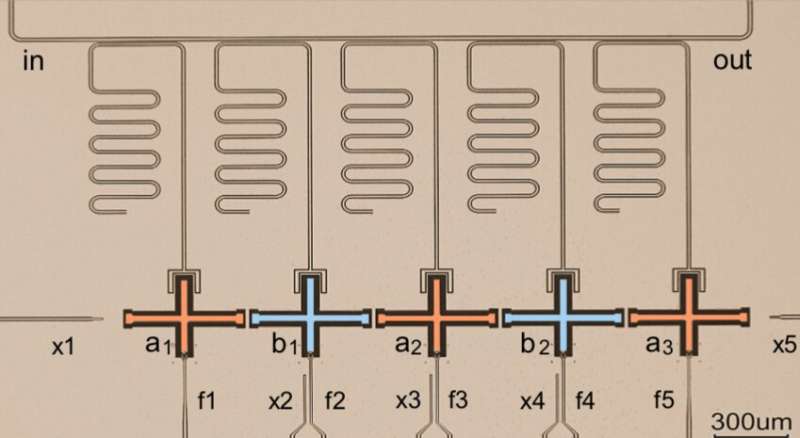September 11, 2019 feature
Observing topological magnon insulator states in a superconducting circuit

Topological states of matter are phases of matter that go beyond the Landau symmetry-breaking theory, which are characterized by topological invariants and topological edge states. Physicist David J. Thouless, in collaboration with F. Duncan, M. Haldane and J. Michael Kosterlitz, unveiled these unique states of matter, winning the Nobel Prize in Physics in 2016.
Since their discovery, topological states of matter have become the focus of a growing number of studies. Researchers from a variety of fields are now actively searching for these states, as observing them could both broaden our current understanding of unusual states of matter and aid the realization of topological quantum computation.
In a recent study, a team of researchers at Tsinghua University, Shanxi University and South China Normal University was able to observe topological magnon insulator states in a superconducting circuit. Their paper, published in Physical Review Letters, is the first to show how a qubit chain can be flexibly tuned into topologically trivial or nontrivial magnon insulator states.
"The concept of topological states originally comes from solid-state electronic systems," Feng Mei, one of the researchers who carried out the study, told Phys.org. "It now has been expanded to different artificial bosonic systems, including ultracold atoms trapped in optical lattices, artificial photonic and phononic lattices."
Over the past few years, researchers have made substantial progress in achieving scalable quantum computation using superconducting circuits. For instance, IBM and Google both claimed to have successfully engineered qubit lattices with 50 and 72 qubits, respectively. Inspired by these findings, Mei and his colleagues started wondering whether they could realize a topological state in a qubit chain, attaining a"topological protection" for the qubits.
"In our work, for the first time, we demonstrate that superconducting qubit chains can support topological magnon insulator states and have topological protection," Mei said. "Our work exhibits that superconducting quantum computing platform also can be used for realizing topological states of matter. In addition, it opens opportunities for implementing topologically protected quantum information processing."
In condensed matter physics, magnons are collective excitations of the electrons' spin chain in a crystal lattice. A topological magnon insulator, on the other hand, is a new topological state associated with magnons, which is characterized by the topological invariant.
The system investigated by Mei and his colleagues has a topological winding number associated with one-dimensional systems. In other words, when its topological winding number is anything other than zero, the system is in its topological insulator states.
"According to bulk-edge correspondence, the nonzero topological winding number guarantees the existence of topological edge states," Luyan Sun, another researcher involved in the study, told Phys.org. "Thus, topological winding number and topological edge state are the two seminal hallmarks of topological insulators. However, they have not been simultaneously observed in any topological systems before."
In their study, Mei and Sun used a chain of qubits, each of these qubits being a superconducting circuit. As they demonstrated in a previous study, the effective coupling between neighboring qubits can be tuned by parametrically modulating the qubits' frequencies.
"The effective coupling strength characterizes the energy exchanging rate between neighboring qubits," Sun said. "It can be tuned to be arbitrarily smaller than the static coupling strength that is determined by the geometry of the device. In our device, all qubits are frequency-tunable and can be controlled by individual external flux bias lines."
Their setup and procedure allowed the researchers to simply tune the qubit chain into topological and non-topological states (i.e. turning these states 'on' or 'off) by changing the qubit coupling configurations. In their experiment, they simply excited one of the qubits (i.e. a magnon) and then monitored its dynamics within the qubit chain. The observations they gathered allowed them to probe both the system's topological winding number and its topological edge states.
"We only consider single-qubit excitation and realize the noninteracting topological states," Mei said. "If we consider putting multiple qubit excitations into the qubit chain, interacting symmetry-protected topological states also can be realized and explored in this system. Our findings imply that a superconducting qubit chain can be used as a versatile platform for exploring different noninteracting and interacting symmetry-protected topological states of matter."
The recent study carried out by Mei, Sun and their colleagues demonstrates that topological states of matter can also emerge in a superconducting qubit chain. In addition, it provides valuable insight about the realization of topological protection for qubits in a chain. This could promote the development of topologically protected quantum information processing techniques.
In their future work, the researchers plan to realize symmetry-protected interacting topological states of matter. In addition, they hope to uncover ways to implement topologically protected quantum information processing tasks using superconducting qubit chains.
"Symmetry-protected interacting topological states are important interacting topological states of matter and their realization currently is still a great challenge," Mei said. "Superconducting qubit chains with multiple qubit excitations provide a natural platform for realizing such states. With the topological protection endowed by the topological states, we will go on to study how to realize topologically protected quantum information processing tasks, such as topologically protected quantum state transfer."
More information: W. Cai et al. Observation of Topological Magnon Insulator States in a Superconducting Circuit, Physical Review Letters (2019). DOI: 10.1103/PhysRevLett.123.080501
X. Li et al. Perfect Quantum State Transfer in a Superconducting Qubit Chain with Parametrically Tunable Couplings, Physical Review Applied (2018). DOI: 10.1103/PhysRevApplied.10.054009
Journal information: Physical Review Letters
© 2019 Science X Network





















